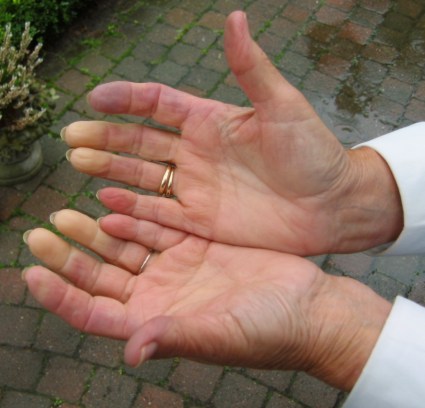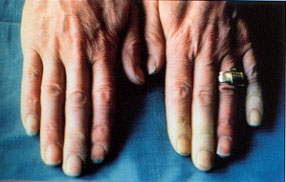Raynaud's phenomenon: Difference between revisions
No edit summary |
No edit summary |
||
| Line 14: | Line 14: | ||
}} | }} | ||
{{ | {{Raynaud's phenomenon}} | ||
'''Editors-In-Chief:''' Asghar Fakhri, M.D., Duane S. Pinto, M.D. and C. Michael Gibson, M.S., M.D. | '''Editors-In-Chief:''' Asghar Fakhri, M.D., Duane S. Pinto, M.D. and C. Michael Gibson, M.S., M.D. | ||
Revision as of 17:04, 21 August 2012
For patient information click here
| Raynaud's phenomenon | |
 | |
|---|---|
| Hands with Raynaud's phenomenon | |
| ICD-10 | I73.0 |
| ICD-9 | 443.0 |
| DiseasesDB | 25933 |
| MeSH | D011928 |
|
Raynaud's phenomenon Microchapters |
|
Diagnosis |
|---|
|
Treatment |
|
Case Studies |
|
Raynaud's phenomenon On the Web |
|
American Roentgen Ray Society Images of Raynaud's phenomenon |
Editors-In-Chief: Asghar Fakhri, M.D., Duane S. Pinto, M.D. and C. Michael Gibson, M.S., M.D.
Overview
Raynaud's phenomenon (RAY-noz), in medicine, is a vasospastic disorder causing discoloration of the fingers, toes, and occasionally other extremities, named for French physician Maurice Raynaud (1834 - 1881). The cause of the phenomenon is unknown, but emotional stress and cold are classically triggers, and the discoloration follows a characteristic pattern in time: white, blue and red. It comprises both Raynaud's disease (primary Raynaud's), where the phenomenon is idiopathic, and Raynaud's syndrome (secondary Raynaud's), where it is secondary to something else.
Incidence
The phenomenon is more common in women than men, with the Framingham Study finding that 5.8% of men and 9.6% of women suffered from it.
Epidemiology
There is a familial component to primary Raynaud's, and presentation is typically before 30. Smoking worsens frequency and intensity of attacks, and there is a hormonal component. Sufferers are more likely to have migraine and angina than controls.
Associated Conditions
Secondary Raynaud's has a number of associations:
- Connective tissue disorders:
- Eating disorders
- Obstructive disorders
- Drugs
- Beta-blockers
- cytotoxic drugs - particularly chemotherapeutics and most especially bleomycin
- cyclosporin
- ergotamine
- sulfasalazine
- Occupation
- jobs involving vibration, particularly drilling
- exposure to vinyl chloride
- exposure to the cold (e.g. by working packing frozen food)
- Others
- hypothyroidism
- cryoglobulinemia
- malignancy
- reflex sympathetic dystrophy
- Acromegaly
- After blunt traumas
- After surgery
- Arsenic
- Arterenol
- Arteriosclerosis Obliterans
- Arteriovenous Fistula
- Arthrosis of cervical spine
- Axillary vein thrombosis
- Carpal tunnel syndrome
- Cervical rib
- Cirrhosis
- Cold agglutinins
- Costoclavicular Syndrome
- Clonidine
- Cryoglobulinemia
- Cytotoxic drugs
- Dermatomtositis
- Dysproteinemia
- Ergotamine
- Heavy metals
- Hemiplegia
- Hormonal contraceptives
- Hypothenar Hammer Syndrome
- Lead
- Leukemia
- Lupus Erythematosus
- Mixed connective tissue disorders
- Multiple Sclerosis
- Neoplasm
- Peripheral Neuropathy
- Peripheral emboli
- Poiliomyelitis
- Polyarteritis Nosdosa
- Polycythemia Vera
- Post-traumatic reflex sympathetic dystrophy
- Propranolol
- Rheumatoid Arthritis
- Scalenus-anticus Syndrome
- Scleroderma
- Scoliosis
- Sjorgen's Syndrome
- Spinal tumor
- Sulfasalazine
- Syringomyelia
- Thallium
- Thromboangitis obliterans
- Thoracic outlet syndrome
- Vibrations
- Wegener's Granulomatosis
It is important to realise that Raynaud's can herald these diseases by periods of more than 20 years in some cases, making it effectively their first presenting symptom. This can be the case in the CREST syndrome, of which Raynaud's is a part.
Diagnosis
Physical Examination
Complete List of Differential Diagnoses
- Acromegaly
- After blunt traumas
- After surgery
- Arsenic
- Arterenol
- Arteriosclerosis Obliterans
- Arteriovenous Fistula
- Arthrosis of cervical spine
- Axillary vein thrombosis
- Carpal tunnel syndrome
- Cervical rib
- Cirrhosis
- Cold agglutinins
- Costoclavicular Syndrome
- Clonidine
- Cryoglobulinemia
- Cytotoxic drugs
- Dermatomtositis
- Dysproteinemia
- Ergotamine
- Heavy metals
- Hemiplegia
- Hormonal contraceptives
- Hypothenar Hammer Syndrome
- Lead
- Leukemia
- Lupus Erythematosus
- Mixed connective tissue disorders
- Multiple Sclerosis
- Neoplasm
- Percussions
- Peripheral Neuropathy
- Peripheral emboli
- Poiliomyelitis
- Polyarteritis Nosdosa
- Polycythemia Vera
- Post-traumatic reflex sympathetic dystrophy
- Propranolol
- Rheumatoid Arthritis
- Scalenus-anticus Syndrome
- Scleroderma
- Scoliosis
- Sjorgen's Syndrome
- Spinal tumor
- Sulfasalazine
- Syringomyelia
- Thallium
- Thromboangitis obliterans
- Thoracic outlet syndrome
- Vibrations
- Vinyl chloride poisioning
- Wegener's Granulomatosis
Symptoms
The condition causes painful, pale, cold extremities. This is often distressing, impinges on quality of life, and is potentially dangerous
Unilateral Raynaud's, or that which is present only in the hands or feet, is almost certainly secondary, as primary Raynaud's is a systemic condition. However, a patient's feet may be affected without his realizing it.
In pregnancy, this sign normally disappears due to increased surface blood flow.
Investigations
A careful history will often reveal whether the condition is primary or secondary. Once this has been established, investigations are largely to identify or exclude possible secondary causes.
- Digital artery pressure: pressures are measured in the digital arteries before and after cooling the hands. A drop of 15 mmHg or more is diagnostic.
- Doppler ultrasound: to assess flow
- Full blood count: this can reveal a normocytic anaemia suggesting the anaemia of chronic disease or renal failure
- Urea & Electrolytes: this can reveal renal impairment
- Thyroid function tests: this can reveal hypothyroidism
- An autoantibody screen, tests for rheumatoid factor, Erythrocyte sedimentation rate and C-reactive protein, which may reveal specific causative illnesses or a generalised inflammatory process
- Nail fold vasculature: this can be examined under the microscope
Laboratory Findings
- Labs include:
- CBC with differential
- TSH
- Hepatitis
- Creatine phosphokinase
- ANA
- ESR
- Rheumatoid factor
Autoantibody Testing
- Anti-double stranded DNA and anti - Sm
- Anti - Sjögren's syndrome
- Anti - CREST syndrome
- Anti - ribonucleoprotein
- Anti - Scl 70
- ANCA
Treatment
Treatment options are dependent on the type of Raynaud's present. Raynaud's syndrome is treated primarily by addressing the underlying cause, but includes all options for Raynaud's disease as well. Treatment of primary Raynaud's focuses on avoiding triggers:
- Avoidance of any environmental triggers, e.g. cold, drilling, etc. (although emotional stress is a recognised trigger, it tends to be impossible to consciously avoid).
- Warm clothing for the extremities such as mittens or HeatBands
- Hormone regulation and assessment of the type of hormonal contraception used, if any. Contraception which is low in estrogen is preferable, and the progesterone only pill is often prescribed.
- Smoking cessation.
- Drug treatment is normally with a calcium channel blocker, frequently nifedipine to prevent arterioconstriction. It has the usual side effects of headache, flushing, and ankle edema, and patients often stop treatment, preferring the symptoms of Raynaud's to the symptoms of the drug.
- The extract of the Ginkgo biloba leaves (Egb 761, 80mg) reduces symptoms in two weeks.
- There is some evidence that Angiotensin II receptor antagonists (often Losartan) reduce frequency and severity of attacks.
- In intractable cases, sympathectomy and infusions of prostaglandins, e.g. prostacyclin, may be tried, with amputation in exceptionally severe cases.
- Alpha-1 adrenergic blockers such as prazosin can be used to control Raynaud's vasospasms under supervision of a health care provider.
- In a study published in the November 8, 2005 issue of Circulation, sildenafil (Viagra) improved both microcirculation and symptoms in patients with secondary Raynaud's phenomenon resistant to vasodilatory therapy. The authors, led by Dr Roland Fries (Gotthard-Schettler-Klinik, Bad Schönborn, Germany), report: "In the present study, capillary blood flow was severely impaired and sometimes hardly detectable in patients with Raynaud's phenomenon. Sildenafil led to a more than 400% increase of flow velocity."
- Two separate gels combined on the fingertip (somewhat like two-part epoxy, they cannot be combined before use because they will react) increased blood flow in the fingertips by about three times. One gel contained 5% sodium nitrite and the other contained 5% ascorbic acid. The milliliter of combined gel covered an area of ~3 cm². The gel was wiped off after a few seconds. Tucker, A.T. et al., The Lancet, Vol. 354, November 13, 1999, pp..
See also
References
External links
de:Raynaud-Syndrom ko:레이노 현상 it:Fenomeno di Raynaud nl:Fenomeen van Raynaud fi:Raynaud'n oireyhtymä
